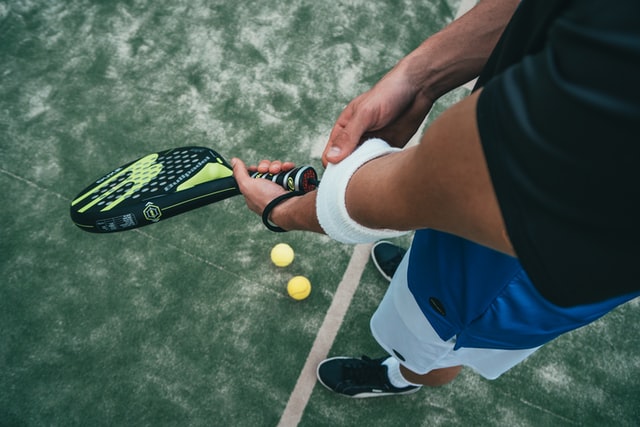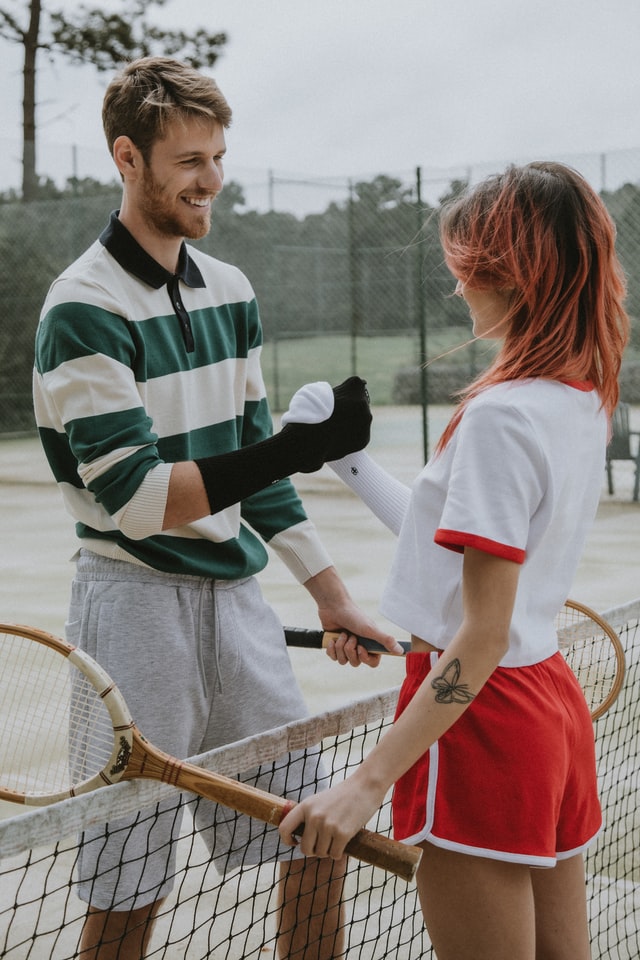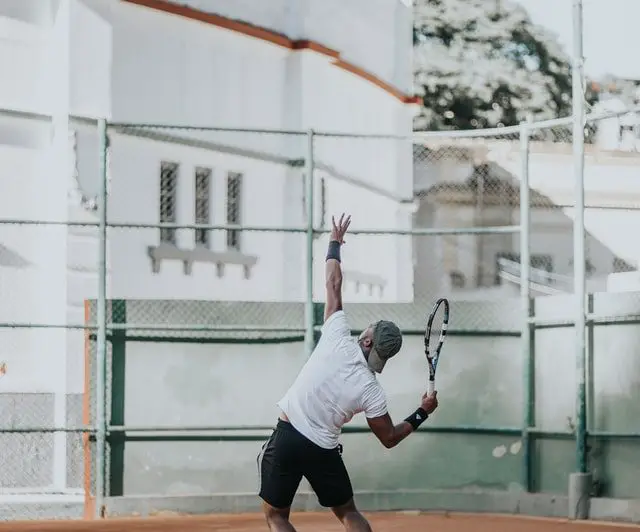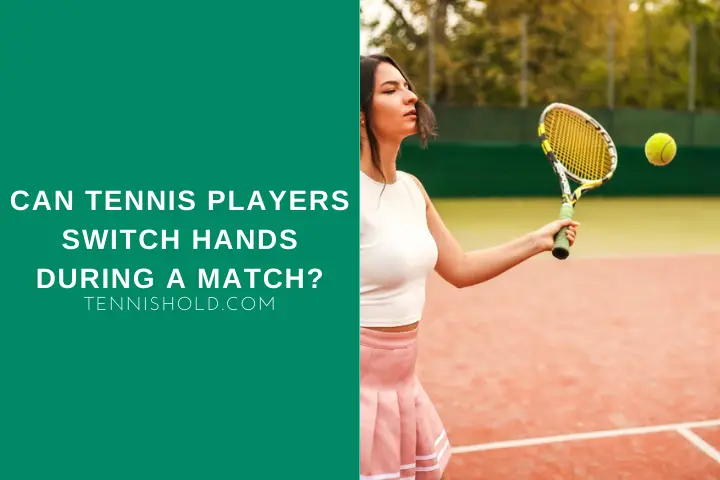Do you dread hitting a backhand? Wouldn’t it be fantastic if you could just hit a forehand on both sides?
Are you allowed to hit with your right hand on one side and left hand on the other?
In tennis, you can switch hands when playing. The ITF rules do not explicitly state whether you can or cannot switch hands. They do, however, state that the racket must be in the hands of the player when contacting the ball.
This can be interpreted that you can hit with either hand as long as you hold the racket as it hits the ball.
In this article I will be covering:
- Whether you can switch hands in a tennis match
- If you can train yourself to play with your other hand
- Whether ambidextrous players have an advantage in tennis
There are several good reasons as to why you shouldn’t switch hands. I will be sharing them later.
Is It Legal To Switch Hands In Tennis During Match?

You can legally play with both hands but whether it is a good idea is another thing. It takes more time to switch hands. It is much quicker to hit a backhand than pass the racket to your other hand.
As you play against stronger opponents, this tactic of switching hands will become even tougher. More advanced players will be able to hit the ball faster than beginners. This thus means that you will have to respond quickly. As a result, you will have less time to switch hands.
This is the main reason the ready position in tennis is with the racket in the middle. It is so that the player is prepared to receive either a forehand or a backhand.
If you begin with the racket tilted to one side, it will make it harder to react as you have further to move it.
There have been a handful of players known to play with both hands on their forehand and backhand. Two of the best known for this are Marion Bartoli and Fabrice Santoro. Both are french.
While it is sporadic, it is not unknown for people to hit forehands on both sides. They do this by switching the racket from left hand to right and vice versa.
One of the best-known players to hit forehands on both sides (switching hands) is the Korean Cheong-Eui Kim. In 2015 he reached #296 in the ATP singles rankings.
If you would like to see a video of Kim in action, check this out.
https://www.youtube.com/watch?v=8iosXeyBb9U
I’ve been a coach for 10 years, and I’ve never worked with anyone who continues to hit two forehands. So I would be very interested to learn the story behind Kim’s two forehands.
Also, I’ve never met a coach who recommends this strategy.
Can You Re-Learn To Play With The Opposite Hand?

You may have been right-handed your entire life. But, what happens if you have a severe accident that means you can longer play with your right hand?
Is it possible to re-train and get to the same standard playing left-handed?
I know someone who personally experienced this. A friend of mine was involved in a bad motorcycle accident. After the accident, he was unable to use his right arm in the same way.
He couldn’t grip the racket.
After recovering from the accident, he was determined to get back on the court. Unfortunately, using the right hand was no longer an option, so he started from scratch as a new beginner hitting left-handed.
He began first hitting with red balls, then moving on to orange, green, and then yellow. Red, orange, and green balls are designed to bounce slower. They are usually aimed at children but are often used by beginner adults.
He spent 2 hours per week on-court training to play left-handed. After one year, he felt that his skill as a left-hander was the same as when he was right-handed.
He didn’t just stop here. A few years later, he went onto becoming a coach.
Perhaps the most remarkable example of someone re-training is Rafael Nadal. When he began playing, he hit with two hands on both sides. As a result, people could not tell whether he was left or right-handed.
On the advice of his uncle (and coach), Toni Nadal, he decided to become a left-handed player.
Toni advised him to do this as left-handed players create a different kind of spin on the ball when serving. This is because they contact the ball from a different angle.
Do Ambidextrous Players Have Advantage In Tennis?

Being ambidextrous is not an advantage in itself. Instead, the edge comes from having the ability to choose whether you play right or left-handed.
Being ambidextrous is no guarantee that you will be able to switch hands quicker. The issue comes not just from the ability to hit forehands on both sides. The problem is the time it takes to change hands.
I mentioned Rafal Nadal in the last section. He is, without doubt, the most famous ambidextrous player in the world.
While he only plays with his left hand in matches, he uses his right hand for everything else.
Rafa says that he writes with his right hand. He also mentions that his basketball skills are more dominant with his right hand, but he cannot play tennis with his right hand.
When you think about it, being ambidextrous is not something you are born with. It is just a case that you have trained to be equally strong on both sides.
You can describe Nadal as naturally right-handed but someone who has trained themself to play left-handed.
When I have new players (usually children) who come to me and tell me they are ambidextrous, I do a simple test to help them decide which hand to play with.
I get them to lay the racket on the floor and pick it up with one hand. They will usually pick it up with the hand they are more comfortable with, even if they don’t know it consciously.
If you genuinely are ambidextrous and beginning with tennis, it might be wise to train to be a left-hander. This would be the same reason as Nadal. You can create a type of spin that right-handers cannot.
About 90% of the global population is right-handed. That means that roughly 90% of the opponents you face in tennis will also be right-handed.
The result of this is that you, as a left-hander, are a challenge that opponents only come across 10% of the time, and they will need to adapt.
This will give you the advantage you are after.
Final Words
As a coach, I cannot think of when I would ever recommend someone hitting with two forehands.
Cheong-Eui Kim proves that it is clearly possible, though.
Have you ever tried hitting two forehands? Perhaps you have a different unorthodox playstyle?

